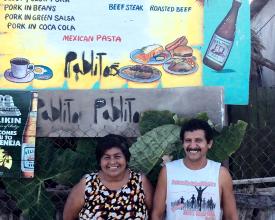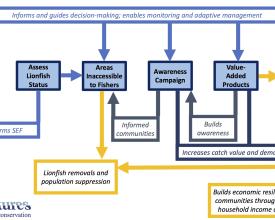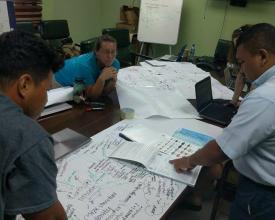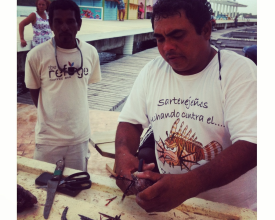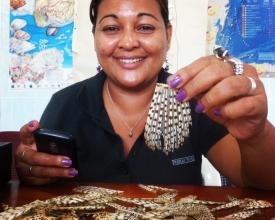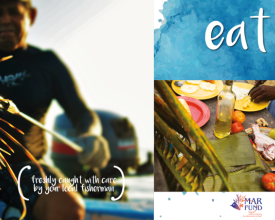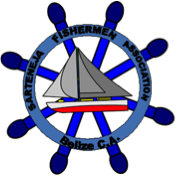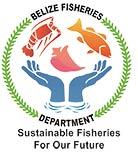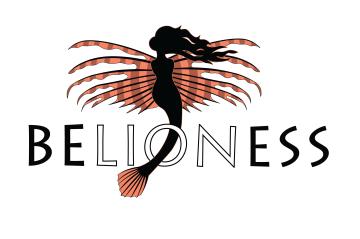
Creación de un mercado para el control del pez león invasor
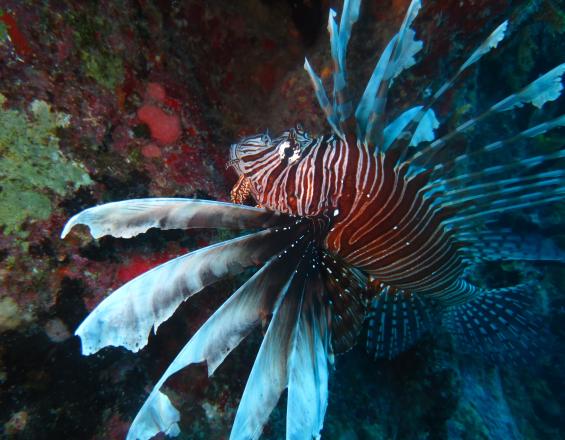
El pez león del Indo-Pacífico es una gran amenaza para los arrecifes del Caribe. Blue Ventures es pionera en Belice en la pesca del pez león, creando un incentivo económico para la eliminación sostenida de esta especie invasora, al tiempo que proporciona un objetivo alternativo para los pescadores y promueve las industrias artesanales asociadas, reduciendo la dependencia de la pesca tradicional. Este esfuerzo se apoya en una estrategia integrada de control del pez león, que ayuda a evitar resultados imprevistos, y también detalla métodos alternativos de eliminación selectiva para lugares donde la pesca no está permitida o no es práctica.
Contexto
Défis à relever
- Pez león invasor
- Seguridad de los medios de subsistencia
- Necesidad de diversificar la pesca
Las poblaciones invasoras de pez león tienen un impacto directo y negativo en la biomasa de peces autóctonos y, a su vez, serán perjudiciales para la pesca tradicional y el bienestar socioeconómico de las comunidades pesqueras. Se ha demostrado que la supresión de las poblaciones de pez león mediante extracciones selectivas protege a las poblaciones de peces de arrecife. Aún no se ha evaluado el impacto del pez león invasor sobre las poblaciones de invertebrados y las pesquerías, aunque los invertebrados constituyen una gran proporción de la dieta del pez león en Belice.
Los esfuerzos actuales de eliminación del pez león son insuficientes para suprimir eficazmente las poblaciones. La diversificación de la pesca es necesaria debido al creciente número de pescadores y a la disminución de las poblaciones de especies de valor comercial.
Ubicación
Procesar
Resumen del proceso
La realización de una evaluación exhaustiva de la población del pez león y la creación de una estrategia de gestión del pez león que utilice un enfoque de sistemas humanos y naturales combinados permiten tomar decisiones con conocimiento de causa para maximizar los beneficios de las actividades de control del pez león y minimizar los resultados imprevistos. La concienciación sobre la invasión del pez león cataliza el interés público por participar en su gestión. Los compradores, exportadores, importadores y restaurantes se vuelven más proclives a comprar pez león, lo que a su vez anima a los pescadores a capturarlo para satisfacer la demanda. Al añadir valor a través de la joyería y los productos procesados, el pez león seguirá siendo objeto de pesca y las empresas locales se beneficiarán del aumento de ingresos. Las mujeres de la zona también adquieren nuevas habilidades y obtienen una nueva fuente de ingresos, con lo que aumentan sus ingresos familiares.
Bloques de construcción
Adoptar un enfoque de sistemas humanos y naturales acoplados
La dinámica de los sistemas humanos y naturales es compleja y se caracteriza por retroalimentaciones recíprocas que pueden interactuar a escalas local y global. El éxito de la gestión de los recursos naturales exige una mejor comprensión de estos sistemas humanos y naturales acoplados (CHANS), que debe incorporarse en la fase de planificación. Un enfoque CHANS implica tanto aspectos ecológicos como sociales, y requiere un equipo interdisciplinar para desarrollar un marco conceptual de interacciones socioecológicas (SEF), que ayude a todos los actores a considerar los posibles resultados desde muchas perspectivas diferentes.
Dado que un programa viable de control del pez león repercutirá en un amplio abanico de partes interesadas, es crucial desarrollar una estrategia de gestión del pez león utilizando un enfoque CHANS para maximizar los beneficios y minimizar los resultados imprevistos.
Un modelo de dinámica poblacional que estime la abundancia, biomasa y estructura de tallas de la población de pez león en diferentes escenarios de gestión es fundamental para la planificación de la gestión del pez león. Los cambios en todos los sistemas afectados pueden entonces interpretarse cualitativamente utilizando el SEF.
Factores facilitadores
- Desarrollar un marco conceptual de interacciones socioecológicas (SEF) con representantes de todas las partes interesadas clave, basado en la investigación social.
- Crear un grupo de trabajo sobre el pez león que se reúna periódicamente para examinar los avances y adaptar la gestión.
- Estimaciones disponibles sobre la situación actual de la densidad, la estructura de tallas y la tasa de capturas(F) del pez león, para alimentar un modelo de dinámica de poblaciones.
- Capacidad o asociación con los expertos pertinentes para apoyar la producción de SEF y la modelización de la dinámica de la población
Lección aprendida
Debido a la naturaleza dinámica e interrelacionada de los sistemas humanos y naturales acoplados, puede que no sea posible prever desde el principio todas las consecuencias de las distintas actividades de gestión. Por ello, una buena estrategia de gestión del pez león debe ser flexible y contar con mecanismos que permitan su evaluación y adaptación.
Maximizar las aportaciones de un amplio abanico de partes interesadas, entre ellas
-
autoridades responsables del desarrollo humano, el medio ambiente, la pesca y los derechos territoriales de los pueblos indígenas
-
asociaciones de pescadores
-
socios académicos
-
sector privado (compradores de marisco, distribuidores, exportadores, restauradores)
-
representantes de las comunidades
-
gestores de zonas protegidas
-
ONG que trabajan en la región
Estimar la situación del pez león y establecer objetivos de capturas
Aunque la erradicación ya no se considera posible, la supresión de la población de pez león permite la recuperación de las poblaciones de peces autóctonos. Dada la enorme variabilidad de la densidad de población del pez león en función de la ubicación, el tipo y la profundidad de los arrecifes, para lograr los resultados ecológicos deseados es necesario combinar la captura comercial, el sacrificio mediante buceo y las trampas en aguas profundas.
Para desarrollar, aplicar y evaluar las intervenciones de gestión, es esencial determinar primero el estado actual de las poblaciones de pez león. Debido a su naturaleza críptica, la densidad del pez león suele subestimarse con las técnicas tradicionales de censo visual submarino; el método de búsqueda focalizada del pez león produce estimaciones más precisas de la densidad de esta especie.
Si se combina con estudios de las poblaciones de peces presa, y siguiendo el método desarrollado por Green et al. (2014: DOI 10.1890/13-0979.1), es posible determinar las densidades umbral del pez león, es decir, la densidad específica del lugar en la que las poblaciones de peces autóctonos pueden recuperarse. Esto proporciona a los gestores un objetivo de gestión y la capacidad de calcular el objetivo de capturas necesario asociado para cada zona con el fin de apoyar la supresión a largo plazo.
Factores facilitadores
- Colaboración con departamentos gubernamentales, expertos pertinentes, centros de buceo y/o un grupo de trabajo activo sobre el pez león.
- Capacidad existente o formación proporcionada para el método de búsqueda centrada en el pez león (LFS), la identificación de peces presa y el uso de R (https://www.r-project.org/)
- Estudios submarinos exhaustivos con el método LFS para determinar el estado de las poblaciones de pez león y peces presa.
Lección aprendida
Las asociaciones eficaces son vitales. Sin la participación de las partes interesadas a todos los niveles -incluidos los departamentos gubernamentales, las comunidades pesqueras, las organizaciones ecologistas, los operadores turísticos y los expertos académicos- este proceso no tendrá éxito. Es necesaria la participación de los expertos pertinentes para impartir formación y/o determinar las densidades umbral del pez león específicas de cada lugar.
Para evaluar el impacto de las intervenciones de gestión sobre las poblaciones de pez león es necesario un seguimiento constante y a largo plazo mediante el método EBL.
Apoyar la pesca emergente del pez león
En las zonas accesibles a los pescadores, la pesca comercial del pez león constituye el medio más viable para lograr su extracción con la frecuencia y el volumen necesarios para suprimir las poblaciones.
Inicialmente, los pescadores se enfrentan a un gran coste de oportunidad al pescar el pez león en lugar de las especies capturadas tradicionalmente, debido al riesgo de picadura del pez león, que puede costar al pescador hasta 24 horas de tiempo de pesca. Esto se ve agravado por un mercado descoordinado y una demanda incoherente y, en algunos casos, una escasa disposición a pagar por el pez león por parte de los consumidores. Por lo tanto, la disposición a pagar por el pez león debe ser mayor que la de las especies capturadas tradicionalmente. Los restaurantes también necesitan tener acceso a un suministro constante de pez león (y una demanda regular por parte de los clientes) antes de incluirlo en sus menús.
Acciones clave:
- Las demostraciones de manipulación segura para pescadores ofrecen formación práctica para
- adaptación de las técnicas de pesca al pez león
- primeros auxilios sencillos para las picaduras de pez león, superando los temores de envenenamiento
- Apoyo a los restaurantes y distribuidores de marisco que quieran comprar pez león, poniendo en contacto a los pescadores con los compradores y ofreciendo ayuda comercial mediante inserciones en los menús y carteles.
- Una campaña de marketing social dirigida a los consumidores para aumentar la demanda y la disposición a pagar por el pez león
Factores facilitadores
- Demostraciones de manipulación segura para que los pescadores se sientan seguros capturando y manipulando el pez león
- Demanda de restaurantes locales y/o distribuidores de marisco locales u orientados a la exportación
- Creación de una cadena de mercado entre pescadores y compradores: catalizar a los pescadores para que se dirijan al pez león y permitir el crecimiento del mercado.
- Campañas de marketing social eficaces para aumentar la demanda de productos derivados del pez león
- Elevada disposición a pagar por el pez león: distribuir materiales para fomentar el consumo de pez león entre los clientes
Lección aprendida
Los pescadores se enfrentan a un gran coste de oportunidad en la pesca del pez león frente a las especies capturadas tradicionalmente, debido a la falta de coordinación del mercado, la inconsistencia de la demanda y la escasa disposición a pagar. Esto se ve agravado por la pérdida de tiempo de pesca de al menos 24 horas en caso de picadura no tratada del pez león. Por lo tanto, la disposición a pagar por el pez león debe ser significativamente superior a la de las especies capturadas tradicionalmente. Los restaurantes necesitan tener acceso a un suministro constante y contar con una demanda regular de pez león antes de incluirlo en sus menús. Una estación central de recepción y unas instalaciones de distribución que comercien sistemáticamente con el pez león a un precio elevado incentivarían a los pescadores a pescarlo de forma constante, además de ofrecer a los restaurantes la garantía de incluir el pez león como producto habitual en sus menús.
Recursos
Productos de valor añadido del pez león
Apoyar a las mujeres de las comunidades pesqueras para que creen, comercialicen y vendan joyas hechas con partes de pez león previamente desechadas añade valor a las capturas de pez león de los pescadores. También satisface varias necesidades simultáneamente: alivio de la pobreza en las comunidades pesqueras, igualdad de género, ya que las mujeres aprenden habilidades y reciben apoyo para ganar dinero de forma independiente, y mayor concienciación sobre el pez león invasor, contribuyendo así a la conservación del ecosistema marino de Belice.
Otros posibles mercados de productos con valor añadido para el pez león son las hamburguesas de pez león, los filetes congelados para su venta en supermercados y los piensos para animales. Las comunidades pesqueras también podrían beneficiarse del establecimiento de plantas de procesamiento de pez león en las propias comunidades, lo que aumentaría la disponibilidad de oportunidades de empleo cualificado y proporcionaría nuevas habilidades a los miembros de la comunidad local.
Factores facilitadores
- Talleres de formación en joyería para mujeres de comunidades pesqueras costeras
- Gestión empresarial y apoyo a la comercialización para joyeros de pez león
- Acceso a kits y recursos para la fabricación de joyas
- Acceso a productos desechados del pez león, como espinas y aletas
- Acceso a mercados para vender productos acabados
Lección aprendida
La joyería del pez león es fácil de adquirir y hay demanda de este producto. El valor de las capturas de pez león de los pescadores beliceños aumenta entre un 13% y un 40% cuando se venden las aletas y las espinas. Establecer el precio de mercado de las aletas y espinas es fundamental para garantizar este beneficio. Por ello, no se debe subvencionar a los joyeros después de los talleres de formación inicial. Los joyeros de regiones que no tienen mercados establecidos para la carne de pez león tienen dificultades para acceder a las partes del pez león; esto puede superarse con una red de joyeros. Una red también fomenta el intercambio de conocimientos, el acceso a diversos puntos de venta, el desarrollo de una marca y un plan de negocio y, en última instancia, el acceso a los mercados internacionales. Al dirigirse a las mujeres de las comunidades pesqueras costeras, se diversifican los ingresos familiares y se empodera a las mujeres. Además, la joyería del pez león puede potenciar la divulgación de esta especie y los propios joyeros se convierten en defensores de la causa, impulsando un cambio de comportamiento hacia una mayor explotación del pez león.
Poner en marcha una campaña de sensibilización
Para establecer un mercado comercial del pez león, es importante comprender las percepciones de las partes interesadas (en particular, los pescadores y los propietarios de restaurantes) y del público en general con respecto a la captura y el consumo del pez león. Por ejemplo, en una encuesta realizada al público en general en Belice en 2015, alrededor de la mitad de los encuestados que no habían comido pez león afirmaron que no probarían una muestra gratuita porque creían que era peligroso. Además, la explotación del pez león se asoció significativamente con el conocimiento sobre la invasión.
Una vez identificados los obstáculos y los conceptos erróneos en torno a la captura/comida del pez león, pueden resolverse mediante la elaboración de un programa de divulgación específico con el público en general y una campaña de marketing social dirigida a restaurantes y consumidores que informe a la gente sobre la invasión del pez león de una manera que refleje las preocupaciones y los valores locales.
Las actividades pueden incluir
- demostraciones culinarias
- presentaciones educativas
- degustaciones de pez león (en colaboración con restaurantes y cocineros locales)
- talleres de manipulación segura
- puestos interactivos y educativos con degustadores de pez león
Factores facilitadores
Encuestas especializadas con grupos concretos:
- entrevistas con pescadores para conocer los obstáculos a la pesca del pez león, incluida la viabilidad económica de los mercados del pez león en comparación con los mercados pesqueros tradicionales
- Cuestionarios con propietarios de restaurantes y proveedores de marisco para conocer las actitudes ante el pez león y los obstáculos a su explotación.
- encuestas entre el público en general para evaluar sus conocimientos sobre la invasión y su percepción del pez león como plato de marisco
Lección aprendida
Para llegar a un público más amplio, las actividades de sensibilización pueden celebrarse en muchos tipos de eventos, como festivales gastronómicos, torneos de pesca del pez león, y con escuelas, restaurantes y excursiones de buceo recreativo.
Lo ideal es que los talleres de manipulación segura se lleven a cabo como un intercambio de conocimientos, dirigidos por un pescador o pescadores que ya se dediquen a la pesca del pez león.
Control del pez león en zonas inaccesibles para los pescadores
Cuando la extracción comercial del pez león no es práctica o no está permitida (como en las zonas protegidas), o si la presión pesquera actual no es suficiente para suprimir las poblaciones de pez león por debajo de los objetivos de gestión específicos del lugar, se puede recurrir a una combinación de métodos de extracción alternativos para reducir las poblaciones de pez león, entre los que se incluyen:
-
sacrificio mediante buceo, ya sea por parte de los gestores de las zonas protegidas o de los operadores de buceo
-
competiciones de sacrificio del pez león (también conocidas como derbis o torneos)
-
las trampas de aguas profundas, aún en fase de diseño, pueden utilizarse como herramienta dentro de un paquete de medidas de gestión del pez león.
Es posible que varias partes interesadas tengan que llevar a cabo una o varias de estas actividades en un lugar determinado para alcanzar el nivel deseado de supresión del pez león.
Factores facilitadores
- Deben conocerse los objetivos de gestión del pez león para poder identificar los lugares controlados de forma ineficaz.
- Un grupo de trabajo sobre el pez león debe estar activo para que la gestión de los lugares prioritarios se base en los mejores conocimientos disponibles.
- El sacrificio con escafandra autónoma requiere un sector del submarinismo activo e informado, así como capacidad para una gestión adecuada y la aplicación de la normativa (por ejemplo, para evitar que los submarinistas capturen otras especies mientras llevan a cabo el sacrificio del pez león).
Lección aprendida
- Dada la naturaleza generalizada de la invasión del pez león y los recursos limitados, es poco probable que las poblaciones de pez león puedan controlarse en todas las áreas de importancia para la conservación. Por lo tanto, los lugares de gestión deben priorizarse a través de un grupo de trabajo sobre el pez león, en consulta con las comunidades y las partes interesadas.
- El sacrificio puede dañar los arrecifes si no se gestiona adecuadamente: los buceadores inexpertos pueden dañar los corales con los arpones, o un permiso especial para el sacrificio del pez león puede dificultar la aplicación de actividades que de otro modo estarían prohibidas (por ejemplo, la pesca submarina dentro de zonas protegidas). Estos problemas deben abordarse antes de poner en marcha cualquier programa.
- Los torneos de pesca del pez león no proporcionan extracciones lo suficientemente regulares como para mantener la supresión de la población del pez león si no se combinan con estrategias adicionales. Sin embargo, constituyen una excelente oportunidad para aumentar la concienciación.
- El riesgo de que las trampas causen daños físicos a los arrecifes o capturen especies accesorias debe eliminarse antes de introducir las trampas.
Impactos
Pesca del pez león
En 2010, ningún restaurante servía pez león. En 2015, el 9% de los restaurantes de Belice declararon servir pez león y compraron a los pescadores el equivalente a 30.000 ejemplares, enteros o en filetes. El precio del pez león a través de este mercado aumentó un 50% en cuatro años (2013-17).
Blue Ventures y la Asociación de Pescadores de Sarteneja (SFA) han participado activamente en la sensibilización de los consumidores, pescadores y restaurantes de Sarteneja sobre los beneficios de la pesca y el consumo de pez león. El 77 % de los pescadores sartenejanos entrevistados en 2016 declararon haber vendido pez león en 2016.
Joyas sobre el pez león
En 2014, un joyero del sur de Belice comenzó a fabricar joyas de pez león en 2014, comprando 5.000 colas a los pescadores anualmente. Esta colección representa el 25% de sus ventas. En 2015, Blue Ventures y SFA crearon un grupo de mujeres (Belioness), con miembros de siete comunidades costeras. Ambas venden joyas de pez león a nivel local y en el extranjero.
La compra de cada cola añade entre un 13% y un 40% al precio de venta del pez león para los pescadores.
Situación del pez león
La densidad del pez león en Belice alcanzó su punto máximo en 2011 (159 peces/ha), disminuyendo a 10 peces/ha en 2015. Las densidades más altas se encontraron en áreas inaccesibles para los pescadores (Zonas de No Pesca). En 2015, se encontró que el 78% de los sitios encuestados estaban efectivamente controlados.
Beneficiarios
Pescadores e industria marisquera, miembros de la comunidad local, especialmente mujeres, y turismo.
Objetivos de Desarrollo Sostenible
Historia

Estrellas Del Mar, conocido cariñosamente como "Pablito's" por todos los que lo frecuentan, se ha convertido en un pilar del mercado del pez león de Sarteneja. Como comprador constante, su fiabilidad como punto de venta para los pescadores ha sido fundamental para ayudar a afianzar la viabilidad de la pesca del pez león en la comunidad. Los pescadores se han beneficiado enormemente de la capacidad de Pablitos para comercializar este producto entre beliceños y turistas. Como resultado directo de los talleres regulares y eventos de degustación de Blue Ventures en Sarteneja, en 2013 Pablito y su esposa Aracely empezaron a servir pez león en su restaurante, preparado de diversas formas; flautas, empanadas, ceviche, empanisado. A pesar de ser una pareja poco convencional en un pueblo conservador, Pablito y Aracely han superado muchas dificultades para tener uno de los restaurantes más populares de la comunidad. Partiendo de una adversidad personal extrema, su perseverancia y naturaleza adaptable les han guiado a lo largo de los años, desde suministrar pollo a los comercios de Sarteneja hasta encargarse de la recogida de basuras. Su capacidad de adaptación les ha convertido en una pareja de emprendedores, rápidos para reconocer y aprovechar una oportunidad rentable. Se levantaron de nuevo para fundar su restaurante hace 13 años. En 2011, Pablito's fue seleccionado por Blue Ventures como sede de su primer taller de preparación de pez león. El pez león es ahora el plato más popular de Pablito's, figura con orgullo en la parte superior de su menú y está pintado a mano en el expositor de su restaurante. Con la ayuda de la campaña de marketing social de Blue Ventures, la modesta pero notable presencia de Pablito en Internet ha enviado a turistas y visitantes curiosos hacia él. Es esta última transición la que ha apoyado la tenacidad de Pablito para mantener a su familia y apoyar la educación de sus tres hijas. Con una hija de 15 años a la que mantener en el instituto y la universidad, Pablito considera que el creciente volumen de turistas, y su apetito por el pez león, es un componente esencial de su educación superior.

